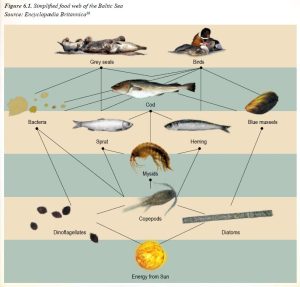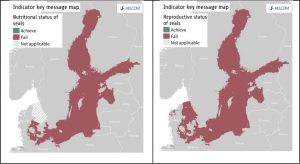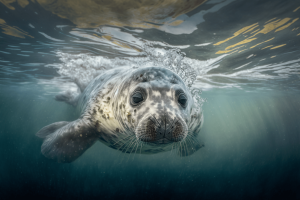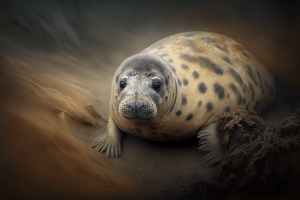Gray seals (Halichoerus grypus), also known as "sea dogs", are a fascinating and interesting species of seal that is often found in the Baltic Sea and is an endangered animal species. With their distinctive appearance and behavior, these animals play a crucial role in maintaining the balance of the Baltic Sea ecosystem. Gray seals are often blamed by fishermen for depleting fish stocks and are the target of hostile attacks. We will take a closer look at the biology, behavior and ecological importance of gray seals, as well as the challenges seals face in surviving in today's world.
Table of Contents
The largest animals of the Baltic Sea
Gray seals are the largest animals found in the Baltic Sea and are easily recognized by their distinctive appearance. These seals have a long, sleek body with a broad, rounded head and a distinctive V-shaped nose. Seals have large, expressive eyes and long whiskers that help them find their prey in murky waters. Gray seals also have a thick layer of blubber that helps them stay warm in cold water and provides good insulation against the cold.
Behaviorally, gray seals are known for their inquisitive and playful nature. These animals enjoy interacting with each other and often engage in social behaviors such as playing, chasing, and talking loudly. Gray seals are also known for their intelligence and ability to solve complex problems and learn.
Despite their playful demeanor, gray seals are powerful predators and play a crucial role in maintaining the balance of the Baltic Sea ecosystem. These animals are opportunistic feeders and eat a variety of prey including fish, crustaceans and cephalopods. By feeding on these species, gray seals help control these populations and prevent one species from dominating the Baltic Sea ecosystem.
The role of gray seals in the Baltic Sea ecosystem
In addition to their role as predators, gray seals also play an important role in the distribution of nutrients. A species of these animals with their tendency to defecate in the sea, their waste is a rich source of nutrients for the surrounding marine ecosystem. This helps to promote the growth of phytoplankton, which forms the basis of the food chain in the Baltic Sea.
However, gray seals face a number of challenges in the modern world, including habitat loss, overfishing and pollution. Climate change is also affecting the Baltic Sea, causing temperatures to rise and changing ocean currents. These changes have significant effects on the food chain, and many species, including gray seals, struggle to adapt.
Gray seals and fisheries in the Baltic Sea
Despite their importance to the ecosystem, gray seals are often threatened by fishermen who blame them for depleting fish stocks. This hostility is fueled by the belief that these seals eat large quantities of fish that would otherwise be caught by humans. However, this perception is not completely accurate, as gray seals consume only a small part of the total fish stock of the Baltic Sea. In fact, a study by Stockholm University found that gray seals consume only 1-3% of the total fish stock in the region and that the real reason for the decline in fish populations is overfishing and other human activities.
In addition, gray seals play an important role in the ecosystem, helping to control the populations of other species such as jellyfish and sea urchins. By consuming these species, gray seals help maintain the delicate balance of the ecosystem by ensuring that one species does not become too dominant and upset the balance of the entire ecosystem.

Despite these important benefits, gray seals are still often the target of attacks by fishermen, who use a variety of methods to drive them away from their fishing grounds, including loud noises, boats and even firearms. In Latvia, it is even allowed to kill seals with firearms. Such hostility towards gray seals is harmful not only to the species, but also to the entire Baltic Sea ecosystem as a whole, as it disturbs the balance of the ecosystem and may lead to the decline of other species.

The number, spatial distribution, fatness and reproductive status of gray seals in the Baltic Sea do not meet the criterion of good status, as shown by the data of "HELCOM Thematic assessment of biodiversity".
Gray seals are protected in the Baltic Sea region
To protect gray seals and their habitat, several conservation measures have been implemented in the Baltic Sea region. These include measures to reduce pollution, protect their breeding grounds and promote sustainable fishing practices. In addition, several organizations, including the World Wide Fund for Nature, are working to raise awareness of the importance of gray seals and their role in the ecosystem.
The gray seal (Halichoerus grypus) is a seal species found in the Baltic Sea. Despite their importance to the ecosystem, gray seals are often blamed by fishermen for depleting fish stocks and are the target of hostile attacks. However, studies show that gray seals consume only a small fraction of the total fish stock in the region and play a critical role in maintaining ecosystem balance by controlling populations of other species. It is important to protect gray seals and the ecosystem as a whole, as their decline can negatively affect the balance of the ecosystem.
Gray seal (Halichoerus grypus) in abandoned fishing nets in the Baltic Sea
References:
- WWF "Grey seals in the Baltic Sea" accessed 10 February 2023, https://www.wwf.de/species/grey-seal.
- IUCN Red List of Threatened Species, “Halichoerus grypus”, accessed 10 February 2023, https://www.iucnredlist.org/
- Stockholm University. (2016). Gray seals and fishing in the Baltic Sea. Stockholm, Sweden.
- HELCOM Thematic assessment of biodiversity, 2018 and HELCOM Core indicators (http://www.helcom.fi/baltic-sea-trends/indicators)



